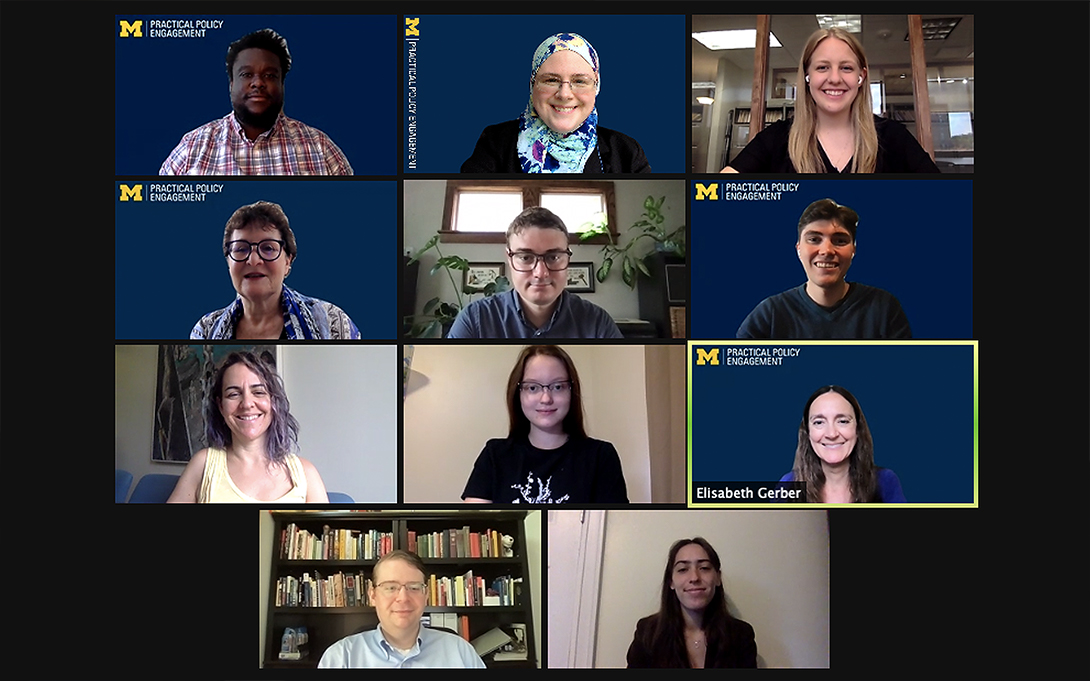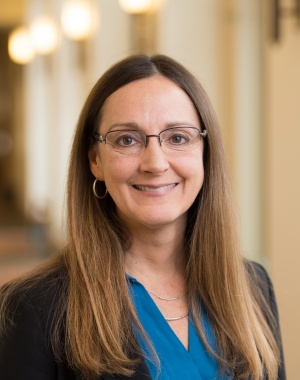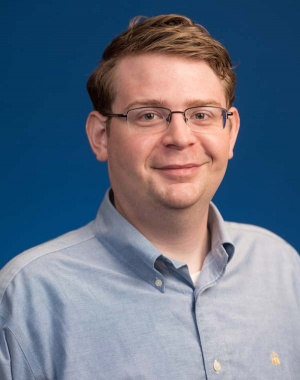
While still operating in a mostly-virtual, hybrid academic world, Ford School students were able to learn and serve during the Spring Term through the Program in Practical Policy Engagement (P3E) and its Practical Community Learning Projects (PCLP). Their work was highlighted at the Spring Showcase. Elisabeth Gerber, P3E director, emphasized the vision of P3E—“to create opportunities that are mutually beneficial for our students to engage with people in organizations outside of the school, to do real world policy projects.” She told the students, “You provide tremendous service for the organizations that serve as our partners.”
DeAndre Calvert, community engagement manager for P3E and PCLP program manager, noted that for the first time one of the projects was done in conjunction with the University of Michigan’s Flint campus. “P3E always says that we are a resource, not only to the Ford School, but the university as a whole, and I feel like this was a great step in creating those partnerships and those resources.”
Here is a recap of the projects:
Michigan Parenting Time Guideline - Accessibility and Usability Evaluation
Brenna Healy (BA ’22) and Gerald Sill (BA ’22)
Partner: State Court Administrative Office Friend of the Court Bureau
Calvert said the partnership goes back to another PCLP project in 2019. “That shows the importance of leveraging relationships. That's community organizing 101.”
Among many roles, the State Court Administrative Office Friend of the Court Bureau (FOC) provides parenting time recommendations, custody information, and child support resources. They recently changed their guidelines.
Healy described the work: “So our role was to get feedback from parents and legal professionals about these new guidelines. In our work, we created two separate surveys: One is targeted towards legal practitioners like lawyers, judges, judges and mediators. The other survey was designed to collect feedback from parents who've worked with the FOC bureau in some way.”
Of the 3,000 that the agency sent out, they quickly received 300 responses, which was a good result (and responses continue to come in).
Sill felt the work is important. “The results of these surveys will help shape the Friend of the Court bureau's efforts in the future to update the guidelines to make sure that they're both accessible and useful to parents and practitioners.”
Their final report highlighted the findings and set goals for future research. They learned about survey styles, for example the importance of using neutral and positive language when surveying members of the public or keeping surveys concise to increase engagement.
More relevant, Sill said, “We learned the importance of public engagement within public policy, especially as the surveys we designed will actually help shape the future of the parenting time guidelines. Making sure that when you design public policy and guidelines that you're directly communicating and getting feedback from the communities that will be affected by the policies you create. That seems to be the best practices of serving the public.”
Analysis of Political Reform Strategies for Michigan
Mandy Mitchell (MPP ’22)
Partner: The Michigan Consensus Policy Project
Mitchell also had worked with the Michigan Consensus Policy Project during the winter semester, looking at research on electoral reform. The Project is made up of former state office holders who are looking for solutions to the state's challenges, specifically solutions that can find support across a broad political spectrum. Previously, Mitchell and a team of Ford School students had examined the “top two” primary, which is used in California and Washington. For this term, she took on ranked choice voting or RCV.
She described the complex system: “The way that this would work is, we would have a common ballot for primary elections, a non-partisan ballot that lists all the candidates from all the parties, so you're not picking a Republican ballot or a Democrat ballot. Then the five candidates who received the most votes in that non-partisan primary will be competing in the general election and there the ranked choice voting rules kick in and voters are going to rank those five candidates in order of preference.”
Advocates say RCV is supposed to improve on the current system, because it removes the penalty for what is called “sincere voting”. RCV is also supposed to reward friendly campaigning. Candidates can say, “Pick me as your number one choice, but pick the other guy as your number two choice.”
“Since we're all very worried about polarization these days, anything that makes politics friendlier is looking pretty good,” she said.
Her most general finding was that there is no precedent for using ranked choice voting in the way that is being considered for Michigan. “The more interesting finding is that if we expand the scope of our analysis, looking at how ranked choice voting works internationally, like in Australia, or in cities like in San Francisco, it looks like it's not really an improvement over our current system.”
“I want to keep this really transparent: there's not really a lot of good data on RCV performance. I looked at a couple of studies that found that RCV depresses turnout. Another study I looked at found that more minorities run for office under RCV but it looks like they don't get elected at higher rates. And it looks like RCV does not make politics or elections less polarized.”
While it is easy to focus on the electoral system, she said, “There are a lot of factors. It's just one mechanism among many. It might be the one that stands out the most but there's lots of other stuff going on that maybe we could change.”
She also noted that she was grateful for the statistics education she received at the Ford School!
AHA Tobacco in School Elimination
Arron McDonald (BA ‘22) and Brenna Goss (BA ‘22)
Partner: American Heart Association
The American Heart Association’s (AHA) Department of Health Strategies works to build and implement plans for policy, system and environment change related to health impacts, especially heart health. McDonald and Goss worked with the Tobacco-free Schools Initiative, which aims to address the public health crisis of youth tobacco use, to help students, teachers and administrators understand what nicotine addiction is and how to treat it without disrupting a student's educational experience.
They produced a spreadsheet that encompassed data on the different school district policies regarding tobacco use from across the state of Michigan, and ranked them one to four, with four being very comprehensive.
McDonald said they found that,” Many schools have policies that are extremely outdated, and so we focused mainly on schools with a score less than four, and schools that raised their score to a four as they updated their policies in 2019, after the federal age was raised to 21. The schools that didn’t update their policies then are using policies from the 1990’s or early 2000’s.”
Goss said one of the most important lessons was the need for advocacy. “Those schools that hadn’t updated their policies pose a large problem as research has changed, the products available have changed, and our attitudes toward addiction have changed. Those policies were stuck in the past. So we think it's really important to actively reach out to the different school districts and not just wait for them to change on their own.”
One of the main focuses of the AHA is to change the policies from strictly punitive measures to measures that support students in addiction recovery, that teach students more lessons about why tobacco use is unhealthy and shouldn't be engaged in, or trying to dispel myths about “vaping is healthier.”
Goss said,”There is a general consensus that, ‘Oh, if you just punish the students, if you just suspend them or make them miss the bus rides or engage in those sorts of policies, that will decrease tobacco use.’ And it really doesn't at all, and it has a doubling negative effect of then decreasing their school performance, worsening graduation rates.”
- Related news: Ford School assists American Heart Association of Southeastern Michigan on ‘Tobacco in Schools’ policies, July 12, 2021.
Policy Primer for Local Government Officials - Landscape Analysis
Nicholas Birdsong (MPP ‘22)
Partner: City of Detroit Department of Civil Rights, Inclusion and Opportunity
Birdsong’s work with the City of Detroit Department of Civil Rights, Inclusion and Opportunity (CRIO) involved helping to develop a policy primer for local government officials, primarily those who are currently sitting on the city's Equity Council, which is made up of executive level staff within the mayor's office and a couple of other departments within city government as well.
The Equity Council mission statement commits to data driven initiatives that work toward demographic parity, are rooted in systemic change, remove barriers in city government, and catalyze change and institutions outside of city government for Detroiters. The Council currently consists of 11 members appointed by the mayor, who are all director cabinet level officials in the city.
“My assignment was to create a policy primer that essentially answered this question for municipal officials: ‘How do I create policy change?’” Birdsong said. “How to create change is a pretty big question, so I began by trying to really understand the needs of public officials and what they might need in response to this question.”
Because the original question was so broad and he only had five weeks, he delivered essentially a 15 page syllabus or overview of lobbying strategy from the perspective of a public official.
He reported, “One of the most important and shareable takeaways, in my opinion, is the idea that big complex, difficult problems can be infinitely more manageable once broken down into smaller and more easily answerable sub questions. It reminded me that being able to provide something useful really depends on knowing your audience, and if you have to work through intermediaries, it can be uniquely challenging.”
Scan of Cybersecurity Training Programs
Molly Ryan (BA ‘22)
Partner: University of Michigan - Flint Office of Economic Development
Ryan did research on best practices for integrating cybersecurity training into the Flint School District.
While the district has been working hard to ensure that Flint residents are both aware of cyberattacks and of the field of cybersecurity, there is very little research on the efficacy of cybersecurity education programs.
The problem is real: in June, the Michigan State police reported that hackers make 90 million attempts every day to access state servers. In 2020 Michigan State University fell victim to a cybersecurity breach. And there is a huge shortage of cybersecurity professionals.
Ryan reported that studies suggest that, “curating a sustainable pipeline is really important for recruiting future cybersecurity talent, a process that involves engaging teens and young adults in cybersecurity programs, including high school cybersecurity curricula.”
Significant barriers to implementing such a curriculum exist, including funding, access to technology, and maintaining interest and support. One next step she suggested for future work is to conduct a survey to gauge interest amongst education district students and staff.
Another suggestion as an introduction was a flexible, scalable and highly interactive video game, which she said was “the best way to prepare cybersecurity professionals.”
As well, the studies she saw suggest, “More in-depth high intensity interventions yield more promising results. So it's best to fully immerse students and training over significant period of time in order for them to fully process the information.”
She prepared a curriculum proposal to take to the Flint School District, and “see if they'd be interested in adopting a cybersecurity module or entire course.”
She said any steps, even at early ages, can help. “Some places have started implementing K through 12 training, so they're showing things to kids who are as young as kindergarteners, explaining how to be safe on the Internet, which is essentially the first step in Internet safety, when we're talking about cybersecurity, not giving out passwords, being careful who you're showing certain things to, it can start very early, which is actually really interesting because many, many people think it's such a complicated topic.”
Soil Reclamation Best Practices Research Review
Sam Stragand (MPP ‘23)
Partner: Michigan League of Conservation Voters
Stragand’s work with the Michigan League of Conservation Voters (LCV) involved examining best practices in soil remediation aspects of aggregate mining, which is mining of gravel and sand that then gets used in local road and construction projects. The state legislature is considering a law that would take regulation power away from local government and create statewide regulation. LCV, a nonpartisan political organization dedicated to protecting Michigan's land, air and water, convened other environmental groups to examine the proposals, and see if they could offer amendments or alternatives.
When use of the mine has been finished, what is the best way to reuse the land for a variety of potential uses -- returning it to natural habitat, creating parks, recreation areas or lakes, or even for farming?
Stragand looked at regulations across the U.S., in the European Union and Australia.
“In my findings, first and most importantly, aggregate mining happens everywhere!” he said. ”It is an incredibly local industry, because it's super cheap to mine aggregate like gravel and rock because it's right at the surface; but it's also incredibly expensive because it's very heavy to move anywhere. Every single county in Michigan has at least one aggregate mine.”
Some of the best examples he saw were creative ways for small companies to pay bonds to put money down, so that if there's anything that goes wrong a locality has money to be able to restore the damage that was done. New ideas include pooling funds among companies, or progressively releasing the funds to encourage proactive reclamation.
He also saw new industry-academia connections around how soil science can influence the decision-making.
The policy landscape is complex, and Stragand noted that government pre-planning for excavation sites, and specificity at the start, means that government resources aren’t needed for the full 10- to 15-year life cycle of a mine.
“The very tricky part is how do you write regulations that are specific enough to enforce, but flexible enough to adapt to new technologies and methods?” he said.
His work is ongoing, and he plans to issue a report on the best practices which the LCV consortium can use as it produces its legislative alternatives.


